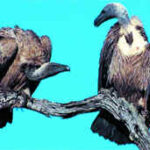Dr. Dhirendra Kumar, Dr. Vikas Mahajan,
Dr. R. K. Taggar and Vibha Raj Shanti
 Parrots melodious sound, Pea fowls dancing step and Sparrow chirping has been entertaining every one since long. But what about Vulture? They neither have an attractive look nor melodies sound. But it has a great ecological significance in maintaining sustainable ecosystem. During the course of time, this bird has been neglected in such a way that their population has declined drastically and now population remain within sixty thousand only. Vultures in India are reeling under the threat of extinction, but seeing of a central Asian scavenger Steppe eagle in the Jammu region has brought many hopes to wildlife experts and environmentalists. The local vultures, though decreasing in number, seem to have offered the well-known Indian hospitality to the guests Vulture. It high time for this Jammu region that Steppe Eagle (guest bird) is finding a favorable environment in this region to reside and breed.
Parrots melodious sound, Pea fowls dancing step and Sparrow chirping has been entertaining every one since long. But what about Vulture? They neither have an attractive look nor melodies sound. But it has a great ecological significance in maintaining sustainable ecosystem. During the course of time, this bird has been neglected in such a way that their population has declined drastically and now population remain within sixty thousand only. Vultures in India are reeling under the threat of extinction, but seeing of a central Asian scavenger Steppe eagle in the Jammu region has brought many hopes to wildlife experts and environmentalists. The local vultures, though decreasing in number, seem to have offered the well-known Indian hospitality to the guests Vulture. It high time for this Jammu region that Steppe Eagle (guest bird) is finding a favorable environment in this region to reside and breed.
There are many reasons which led to decline in the number of population of this bird, which are as follows:
Urbanization
Environmental pollution.
Rampant use of pesticide in agricultural field. Changing habitat.
Despite all, the main culprit is diclofenac. Diclofenac is a drug which is widely used for the treatment of Animal. The residue of diclofenac remains in the body of animal after treatment. When animal dies and vulture feed on animal carcass and they dies due to urinary failure. The mortality of vulture is very high among those which feed on the carcass that had been treated with diclofenac. Due to this very one reason the population of vulture has declined sharply.
Vulture and Ecosystem: Vulture is great scavenger which feed on dead animal carcass. Carcasses which are rotting are the main source of disease spread. Vultures clean the environment by eating the carcass. It not only prevents the disease spread among the animal but also to the human being. During natural calamity like flood, drought etc. it cleans up the putrid carcasses. Major decline in population has disturbed the local environment or the ecological system.
Vulture Breeding: Vulture is slow breeder and usually lays only one egg in a year. According to expert, there is no cross group mating among vulture in one area. In turn, inbreeding reduces survivalist and fertility. Heavy use of pesticide in the field, ultimately go to the vulture which leads to reproductive disorder causing reduced breeding capacity.
Captive Breeding – Some Vulture are kept in captive and breeding is being carried out. Breeding Center’s are operating at Pinjore in Hariana, Rajabhathawa in West Bengal Rani in Assam. Experts are studying the infrastructure and protocols to replicate the breeding success of Pinjore at zoos of Junagarh (Gujrat), Nehru Zoo (hydrabad) and Van Vihar (Bhopal). Artificial Incubation has improved the breeding success of captive vulture. During incubation of eggs the temperature is maintained by the air conditioner and in the same line humidity is also maintained. Balance temperature and humidity is essential for breeding success.
Vulture Safe Zone – To safeguard vulture population, environment ministry has coined the concept named Vulture Safe Zone. It would be zone where the use of drug diclofenac not to be use in the treatment of livestock. Other reasons that also lead to the disappearance of vulture will be prohibited.
Plan for Vulture Conservation – Now the vulture is listed in the Red List of IUCN (International Union for Conservation of Nature) as critically endangered. Therefore, a planed effort is needed in this regard, which may be as follows:
A. Removal of Diclofenac
I. Notification of ban on veterinary use.
II. Search for alternate drugs.
B. Population Survey
I. Data Collection
II. Conservation Strategies
II. (a). In Situ Conservation Methods
In-situ conservation, the conservation of species in their natural habitats, is considered the most appropriate way of conserving biodiversity. Conserving the areas where populations of species exist naturally is an underlying condition for the conservation of biodiversity. That’s why protected areas form a central element of any national strategy to conserve biodiversity.
II. (b). Ex Situ Conservation Methods
Ex-situ conservation is the preservation of components of biological diversity outside their natural habitats. This involves conservation of genetic resources on a diverse body of techniques and facilities. Some of these include:
* Gene banks, e.g. sperm and ova banks, Embryo freezing banks.
* In vitro animal tissue and microbial culture collections.
* Captive breeding of birds and artificial propagation with possible reintroduction into the wild habitat.
Ex-situ conservation measures can be complementary to in-situ methods as they provide an “insurance policy” against extinction. These measures also have a valuable role to play in recovery programmes for endangered species. Ex-situ conservation provides excellent research opportunities on the components of biological diversity.
C. Establishment of Vulture Care and Management Center
D. Establishment of Captive Breeding Center
E. Awareness campaign should be carried out considering
a. Significance of Vulture in ecological balance.
b. Ban on use of diclofenac on Animal.
Trending Now
E-Paper

